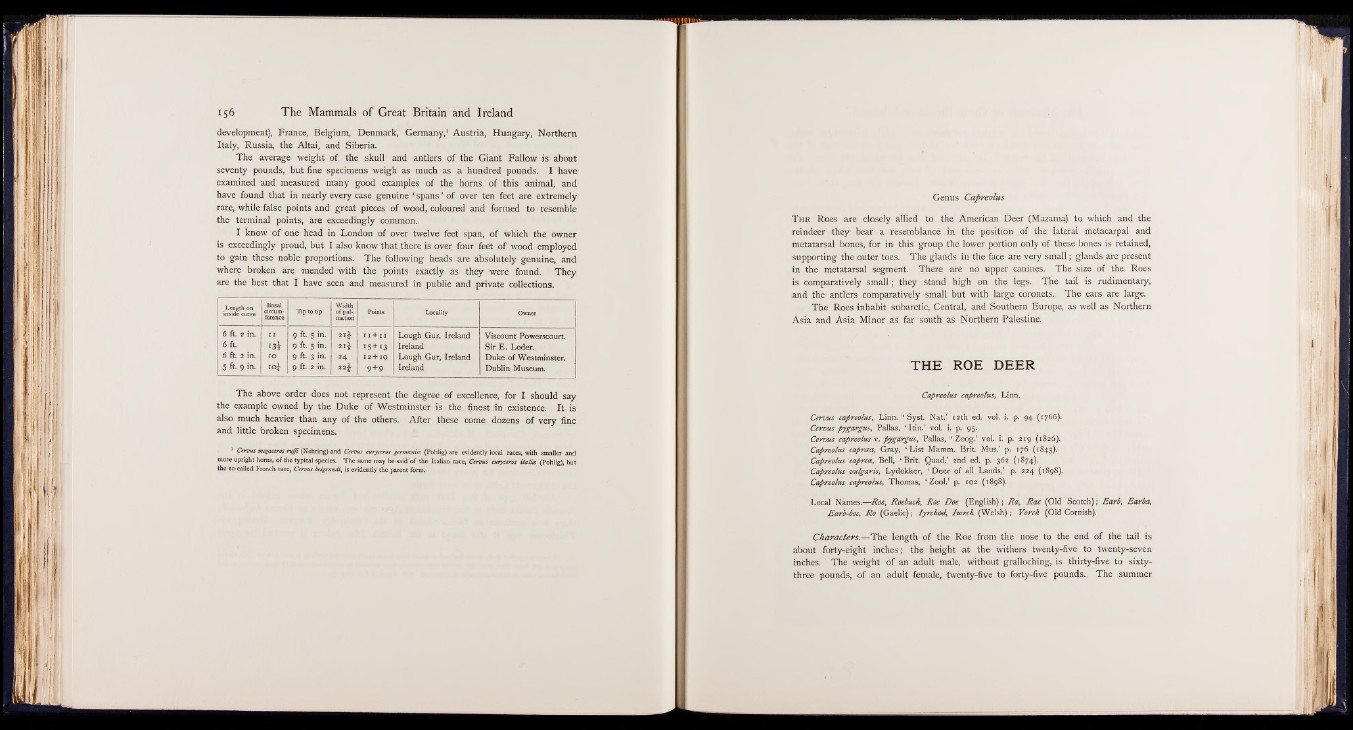
development), France, Belgium, Denmark, Germany,1 Austria, Hungary, Northern
Italy, Russia, the Altai, and Siberia.
The average weight of the skull and antlers of the Giant Fallow is about
seventy pounds, but fine specimens weigh as much as a hundred pounds. I have
examined and measured many good examples of the horns of this animal, and
have found that in nearly every case genuine ‘ spans ’ of over ten feet are extremely
rare, while false points and great pieces of wood, coloured and formed to resemble
the terminal points, are exceedingly common.
I know of one head in London of over twelve feet span, of which the owner
is exceedingly proud, but I also know that there is over four feet of wood employed
to gain these noble proportions. The following heads are absolutely genuine, and
where broken are mended with the points exactly as they were found. They
are the best that I have seen and measured in public and private collections.
inside curve
cBircausamlference
Tip to tip Width
mation Points Locality Owner
6 ft. 2 in. i i 9 f t 5 in. 2Ii I I + I I Lough Gur, Ireland Viscount Powerscourt
6 ft. ±oa 9 ft- 5 in- 2 t 4 1 5 + I 3 Ireland Sir E . Loder.
6 ft. 2 in. I O 9 ft- 3 ‘ t . 24 I 2 + IO Lough Gur, Ireland Duke o f Westminster.
5 ft. 9 in. io£ 9 ft. 2 in. 2 2 j 9 + 9 Ireland Dublin Museum.
The above order does not represent the degree of excellence, for I should say
the example owned by the Duke of Westminster is the finest in existence. It is
also much heavier than any of the others. After these come dozens of very fine
and little broken specimens.
1 Cervus megaceros ruffi (Nehring) and Cervus euryceros germania (Pohlig) are evidently local races, with smaller and
more upright homs, of the typical species. The same may be said o f the Italian race, Cervus euryceros italia (Pohlig), but
the so-called French race, Cervus belgrandi, is evidently the parent form.
Genus Capreolus
T h e Roes are closely allied to the American Deer (Mazama) to which and the
reindeer they bear a resemblance in the position of the lateral metacarpal and
metatarsal bones, for in this group the lower portion only of these bones is retained,
supporting the outer toes. The glands in the face are very small; glands are present
in the metatarsal segment. There are no upper canines. The size of the Roes
is comparatively small; they stand high on the legs. The tail is rudimentary,
and the antlers comparatively small but with large coronets. The ears are large.
The Roes inhabit subarctic, Central, and Southern Europe, as well as Northern
Asia and Asia Minor as far south as Northern Palestine.
T H E R O E D E E R
Capreolus capreolus, Linn.
Cervus capreolus, Linn. * Syst. Nat.’ 12th ed. vol. i. p. 94 (1766).
Cervus pygargus, Pallas, ‘ I tin.’ vol. i. p. 95.
Cervus capreolus v. pygargus, Pallas, ‘ Zoog.’ vol. i. p. 219 (1826).
Capreolus caprcea, Gray, ‘ List Mamm. B r it Mus.’ p. 176 (1843).
Capreolus caprea, Bell, ‘ Brit. Quad.’ 2nd ed. p. 362 (1874).
Capreolus vulgaris, Lydekker, ‘ Deer o f all Lands,’ p. 224 (1898).
Capreolus capreolus, Thomas, ‘ Zool.’ p. 102 (1898).
Local Names.— Roe, Roebuck, Roe Doe (English) ,* R a, Rae (Old Scotch); E arb, Earba,
Earb-boc, R o (Gaelic); Iyrckod, Iw rch (W elsh ); Yorch (Old Cornish).
Characters.— The length of the Roe from the nose to the end of the tail is
about forty-eight inches; the height at the withers twenty-five to twenty-seven
inches. The weight of an adult male, without gralloching, is thirty-five to sixty-
three pounds, of an adult female, twenty-five to forty-five pounds. The summer